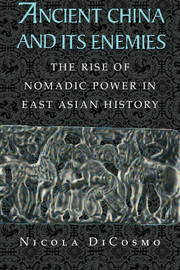Book contents
- Frontmatter
- Contents
- Acknowledgments
- Introduction
- Part I
- Part II
- Part III
- Part IV
- 7 In Search of Grass and Water: Ethnography and History of the North in the Historian's Records
- 8 Taming the North: The Rationalization of the Nomads in Ssu-ma Ch'ien's Historical Thought
- Conclusion
- Glossary
- Select Bibliography
- Index
8 - Taming the North: The Rationalization of the Nomads in Ssu-ma Ch'ien's Historical Thought
Published online by Cambridge University Press: 25 August 2009
- Frontmatter
- Contents
- Acknowledgments
- Introduction
- Part I
- Part II
- Part III
- Part IV
- 7 In Search of Grass and Water: Ethnography and History of the North in the Historian's Records
- 8 Taming the North: The Rationalization of the Nomads in Ssu-ma Ch'ien's Historical Thought
- Conclusion
- Glossary
- Select Bibliography
- Index
Summary
Introduction
The Hsiung-nu chapter of the Shih chi was unprecendented in its presentation of a detailed and realistic account of the nomads to the north of China. However, another aspect of the historiography of the northern nomads must be considered before we can complete our analysis of the northern frontier as it was “formalized” in the Shih chi. Together with his presentation of a full description of the Hsiung-nu empire and the regions of Inner Asia, Ssu-ma Ch'ien was faced with the task of having to “explain” it in terms consistent with his own vision of history. To integrate the Inner Asian nomads (as with any other phenomenon that was truly anomalous and new in Chinese history) within a unified historical frame, Inner Asia had to be understood, or “rationalized,” both according to the intellectual canons of his own age and according to those principles of historical investigation that Ssu-ma Ch'ien set for himself. This “rationalization” of Inner Asia required the seamless juncture of the history of the Hsiung-nu in the flow of Chinese history, following primarily the principle of “comprehensiveness” (t'ung). In addition, the investigation of the relationship between “heaven” and “man,” where “man” obviously had to include all the terrestrial events worthy of being recorded required that Inner Asia be included – for the first time in Chinese historiography – into the system of correlations between celestial and human occurrences that formed such an important pillar of Han thought.
- Type
- Chapter
- Information
- Ancient China and its EnemiesThe Rise of Nomadic Power in East Asian History, pp. 294 - 312Publisher: Cambridge University PressPrint publication year: 2002



